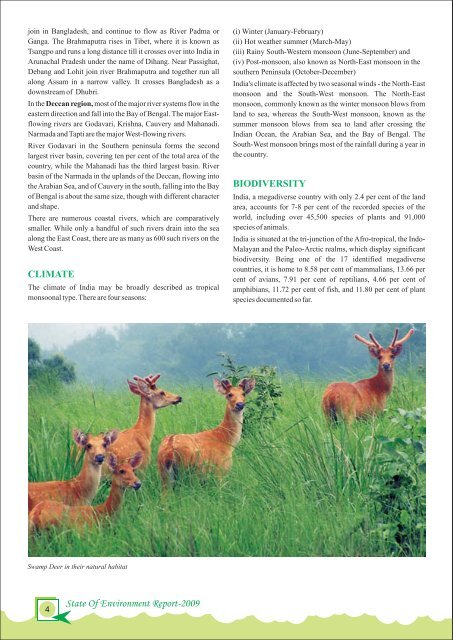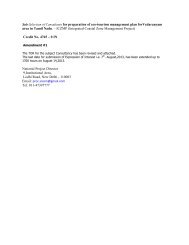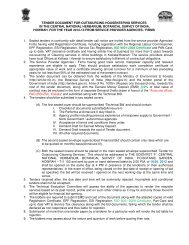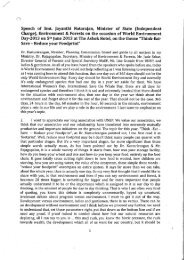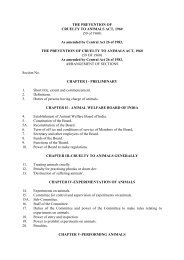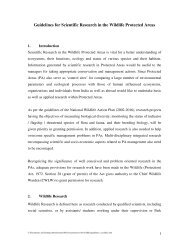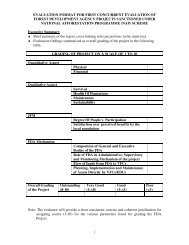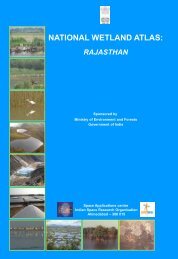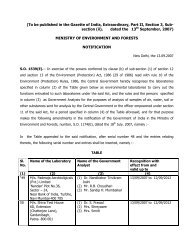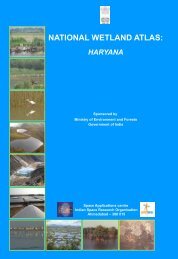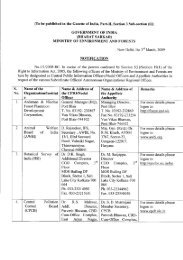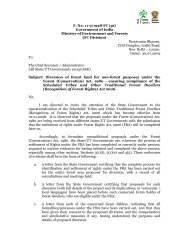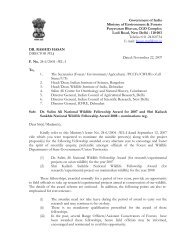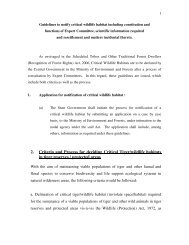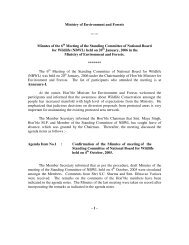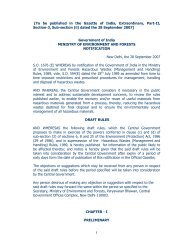lR;eso t;rs - Ministry of Environment and Forests
lR;eso t;rs - Ministry of Environment and Forests
lR;eso t;rs - Ministry of Environment and Forests
Create successful ePaper yourself
Turn your PDF publications into a flip-book with our unique Google optimized e-Paper software.
join in Bangladesh, <strong>and</strong> continue to flow as River Padma or<br />
Ganga. The Brahmaputra rises in Tibet, where it is known as<br />
Tsangpo <strong>and</strong> runs a long distance till it crosses over into India in<br />
Arunachal Pradesh under the name <strong>of</strong> Dihang. Near Passighat,<br />
Debang <strong>and</strong> Lohit join river Brahmaputra <strong>and</strong> together run all<br />
along Assam in a narrow valley. It crosses Bangladesh as a<br />
downstream <strong>of</strong> Dhubri.<br />
In the Deccan region, most <strong>of</strong> the major river systems flow in the<br />
eastern direction <strong>and</strong> fall into the Bay <strong>of</strong> Bengal. The major Eastflowing<br />
rive<strong>rs</strong> are Godavari, Krishna, Cauvery <strong>and</strong> Mahanadi.<br />
Narmada <strong>and</strong> Tapti are the major West-flowing rive<strong>rs</strong>.<br />
River Godavari in the Southern peninsula forms the second<br />
largest river basin, covering ten per cent <strong>of</strong> the total area <strong>of</strong> the<br />
country, while the Mahanadi has the third largest basin. River<br />
basin <strong>of</strong> the Narmada in the upl<strong>and</strong>s <strong>of</strong> the Deccan, flowing into<br />
the Arabian Sea, <strong>and</strong> <strong>of</strong> Cauvery in the south, falling into the Bay<br />
<strong>of</strong> Bengal is about the same size, though with different character<br />
<strong>and</strong> shape.<br />
There are numerous coastal rive<strong>rs</strong>, which are comparatively<br />
smaller. While only a h<strong>and</strong>ful <strong>of</strong> such rive<strong>rs</strong> drain into the sea<br />
along the East Coast, there are as many as 600 such rive<strong>rs</strong> on the<br />
West Coast.<br />
CLIMATE<br />
The climate <strong>of</strong> India may be broadly described as tropical<br />
monsoonal type. There are four seasons:<br />
Swamp Deer in their natural habitat<br />
4<br />
State Of <strong>Environment</strong> Report-2009<br />
(i) Winter (January-February)<br />
(ii) Hot weather summer (March-May)<br />
(iii) Rainy South-Western monsoon (June-September) <strong>and</strong><br />
(iv) Post-monsoon, also known as North-East monsoon in the<br />
southern Peninsula (October-December)<br />
India's climate is affected by two seasonal winds - the North-East<br />
monsoon <strong>and</strong> the South-West monsoon. The North-East<br />
monsoon, commonly known as the winter monsoon blows from<br />
l<strong>and</strong> to sea, whereas the South-West monsoon, known as the<br />
summer monsoon blows from sea to l<strong>and</strong> after crossing the<br />
Indian Ocean, the Arabian Sea, <strong>and</strong> the Bay <strong>of</strong> Bengal. The<br />
South-West monsoon brings most <strong>of</strong> the rainfall during a year in<br />
the country.<br />
BIODIVERSITY<br />
India, a megadive<strong>rs</strong>e country with only 2.4 per cent <strong>of</strong> the l<strong>and</strong><br />
area, accounts for 7-8 per cent <strong>of</strong> the recorded species <strong>of</strong> the<br />
world, including over 45,500 species <strong>of</strong> plants <strong>and</strong> 91,000<br />
species <strong>of</strong> animals.<br />
India is situated at the tri-junction <strong>of</strong> the Afro-tropical, the Indo-<br />
Malayan <strong>and</strong> the Paleo-Arctic realms, which display significant<br />
biodive<strong>rs</strong>ity. Being one <strong>of</strong> the 17 identified megadive<strong>rs</strong>e<br />
countries, it is home to 8.58 per cent <strong>of</strong> mammalians, 13.66 per<br />
cent <strong>of</strong> avians, 7.91 per cent <strong>of</strong> reptilians, 4.66 per cent <strong>of</strong><br />
amphibians, 11.72 per cent <strong>of</strong> fish, <strong>and</strong> 11.80 per cent <strong>of</strong> plant<br />
species documented so far.


